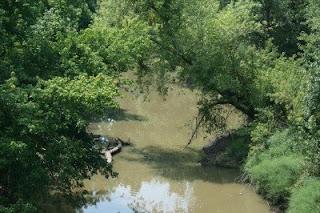
This is a view of the battlefield at Honey Springs looking south from the position of the Union line of battle to the first Confederate defensive position, located in the trees at the fair end of the open prairie.
Following the opening artillery exchange, the Union line move forward across this ground at about 10 a.m. Conditions were hot and rainy.
General Blunt described the attack in his official report:
Without halting, I moved them forward in line of battle, throwing out skirmishers in advance and soon drew their fire, which revealed the location of their artillery. The cavalry, which was on the two flanks, was dismounted and fought on foot with their carbines. In a few moments the entire force was engaged. My men steadily advanced into the edge of the timber, and the fighting was unremitting and terrific for two hours....
The Confederates described the attack in much the same terms, mentioning that other than constant firing by skirmishers, the main battle line held its fire until the Union troops advanced to within 20 or so paces. At this point, the Southern troops opened with massive volleys of fire and the two forces faced each other and fought in an intense battle.
It must have been a stunning scene as thousands of men from the two sides fought for control of the trees on the edge of the open prairie. The Confederates had only four pieces of artillery when the battle began, compared to 12 guns for the Federals, and had lost one of these to accurate Union fire during the artillery exchange. In addition, their defensive effort was weakened by the absence from the field of Colonel Stand Watie, the Confederacy's noted Cherokee commander. He had been sent by General Cooper on a mission to Webber's Falls prior to the battle.
Visiting the battlefield today, it is easy to visualize the scene as it must have appeared in 1863. The ground where the Union troops formed and advanced is open and can be viewed for virtually the entire length of their battle line. The Confederate position remains wooded and probably looks very similar to its Civil War appearance.
Our series on the Battle of Honey Springs will continue.









